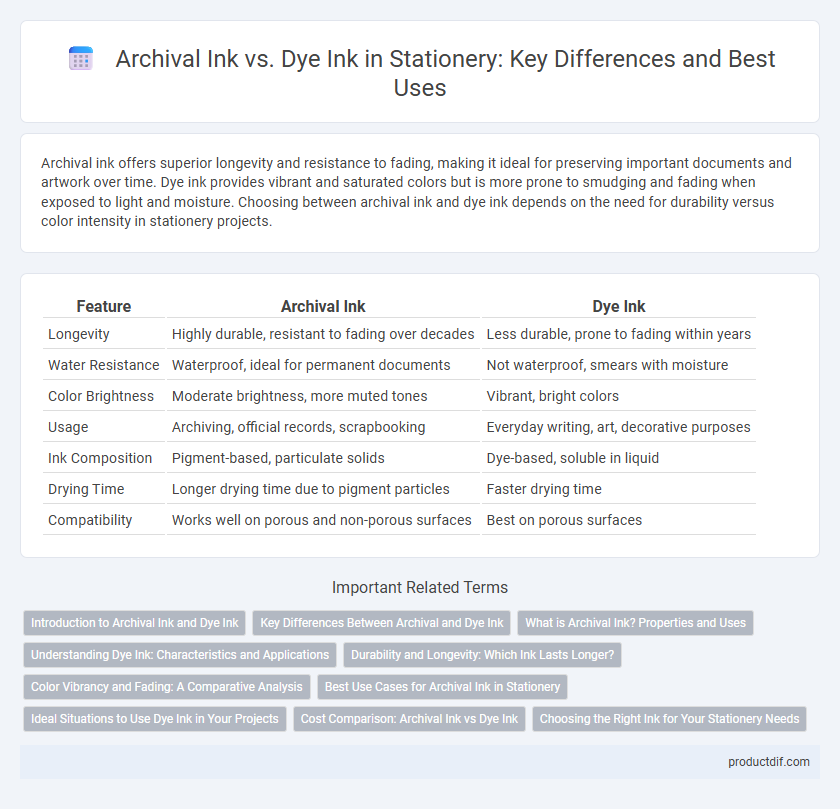Archival ink offers superior longevity and resistance to fading, making it ideal for preserving important documents and artwork over time. Dye ink provides vibrant and saturated colors but is more prone to smudging and fading when exposed to light and moisture. Choosing between archival ink and dye ink depends on the need for durability versus color intensity in stationery projects.
Table of Comparison
| Feature | Archival Ink | Dye Ink |
|---|---|---|
| Longevity | Highly durable, resistant to fading over decades | Less durable, prone to fading within years |
| Water Resistance | Waterproof, ideal for permanent documents | Not waterproof, smears with moisture |
| Color Brightness | Moderate brightness, more muted tones | Vibrant, bright colors |
| Usage | Archiving, official records, scrapbooking | Everyday writing, art, decorative purposes |
| Ink Composition | Pigment-based, particulate solids | Dye-based, soluble in liquid |
| Drying Time | Longer drying time due to pigment particles | Faster drying time |
| Compatibility | Works well on porous and non-porous surfaces | Best on porous surfaces |
Introduction to Archival Ink and Dye Ink
Archival ink is formulated to resist fading, water, and chemical exposure, making it ideal for preserving important documents and artwork over time. Dye ink, composed of soluble dyes, offers vibrant colors but tends to be more susceptible to fading and water damage compared to archival inks. Both ink types serve unique purposes in stationery, with archival ink favored for longevity and dye ink preferred for brightness and sharpness in everyday writing.
Key Differences Between Archival and Dye Ink
Archival ink is formulated with pigment particles that resist fading, water, and chemicals, ensuring long-lasting, durable prints ideal for documents and artwork preservation. Dye ink consists of water-soluble dyes that produce vibrant colors but are more prone to fading and smudging over time when exposed to moisture and light. The key difference lies in archival ink's superior longevity and water resistance compared to the vivid but less durable nature of dye ink.
What is Archival Ink? Properties and Uses
Archival ink is a type of ink designed for long-lasting, fade-resistant writing and printing, often composed of pigment-based particles that resist water, UV light, and chemicals. Its properties include high durability, acid-free composition, and resistance to smudging, making it ideal for preserving important documents, artwork, and photographs. Archival ink is widely used in professional settings such as museums, libraries, and legal offices where document longevity and clarity are critical.
Understanding Dye Ink: Characteristics and Applications
Dye ink consists of colorants that dissolve completely in the liquid, offering vibrant colors and smooth flow ideal for detailed artwork and everyday printing. It exhibits excellent color brightness and sharpness but tends to be less water-resistant and fade-resistant compared to archival ink. Commonly used in offices and homes, dye ink is suitable for printing photos, documents, and craft projects where longevity is less critical.
Durability and Longevity: Which Ink Lasts Longer?
Archival ink offers superior durability and longevity compared to dye ink, as it is formulated to resist fading, water, and chemical exposure over time. This permanence makes archival ink ideal for documents and artworks requiring long-term preservation. Dye ink, while vibrant and quick-drying, tends to fade faster due to its water-soluble nature and susceptibility to environmental damage.
Color Vibrancy and Fading: A Comparative Analysis
Archival ink exhibits superior color vibrancy and long-lasting resistance to fading compared to dye ink, maintaining its richness on various paper types over extended periods. Dye ink, while initially brighter and more vivid, tends to fade faster when exposed to light and moisture, compromising the durability of documents. For archival-quality stationery and preservation, archival ink is preferred due to its chemical composition that prevents color degradation and ensures consistent print quality over time.
Best Use Cases for Archival Ink in Stationery
Archival ink, known for its fade resistance and water permanence, is ideal for preserving important documents, certificates, and artwork in stationery applications. Its pigment-based composition ensures longevity and smudge-proof quality, making it perfect for legal papers, scrapbooking, and archival projects that require durability over time. Stationery items such as invitations, archival letters, and official records benefit from archival ink's superior preservation properties compared to dye ink.
Ideal Situations to Use Dye Ink in Your Projects
Dye ink is ideal for projects requiring vibrant colors and quick drying times, such as greeting cards, scrapbooking, and everyday note-taking. Its water-based formula ensures smooth application on porous surfaces like paper, making it perfect for colorful prints and intricate designs. However, dye ink is less suitable for documents needing long-term preservation due to potential fading and water sensitivity.
Cost Comparison: Archival Ink vs Dye Ink
Archival ink generally costs more upfront compared to dye ink due to its long-lasting, fade-resistant properties that preserve documents over time. Dye ink is more affordable but tends to fade faster, making it suitable for everyday printing where cost efficiency is prioritized. Businesses must weigh the higher initial investment of archival ink against potential replacement expenses when dye ink fades or degrades.
Choosing the Right Ink for Your Stationery Needs
Archival ink offers superior longevity and resistance to fading, making it ideal for preserving important documents and artwork. Dye ink provides vibrant colors and quick drying times, suitable for everyday writing and colorful stationery projects. Selecting the right ink depends on whether durability or color intensity is your primary stationery requirement.
Archival Ink vs Dye Ink Infographic

 productdif.com
productdif.com